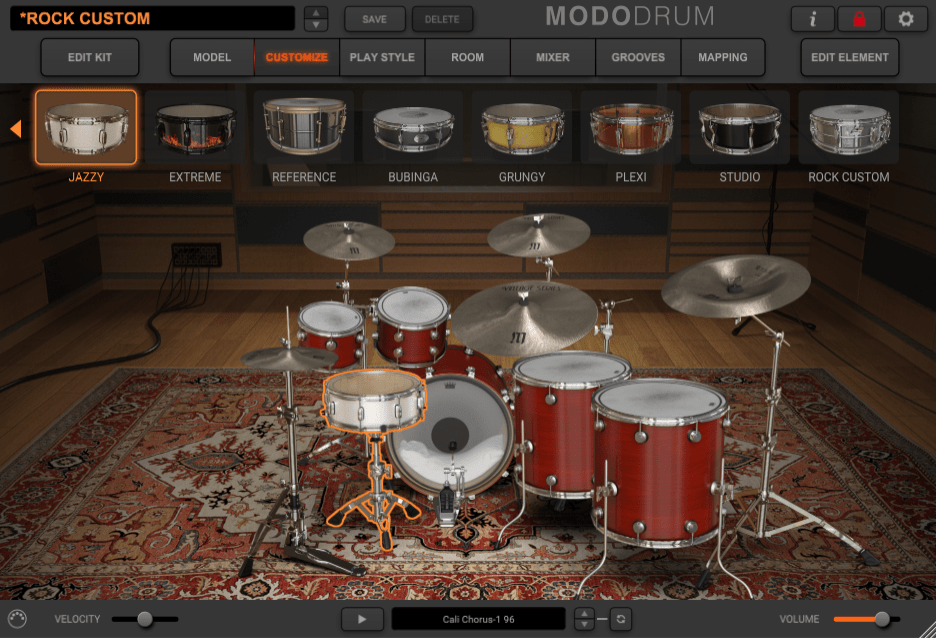If you enjoy this review and decide to grab the deal, please consider clicking through one of my links before you buy. I earn a small commission at no cost to you, which helps support this site and keep the reviews coming. Thanks!
Next on my list of drum virtual instrument plugins to review in this best-of series is IK Multimedia’s MODO DRUM. Out of the bunch, MODO DRUM is the only plugin with physically modeled sounds instead of samples. A modeler won the piano roundup, so how will MODO DRUM fare in the drum roundup? Let’s check it out.
Looks

MODO DRUM opens to an angled view of a drumkit on the Model screen, which allows you to pick one of ten drumkit models. On the top right is a preset loader with Save and Delete, and on the top right is the settings menu. Along the bottom are MIDI, velocity, groove loader with playhead, and a master plugin output volume. The Customize tab gives piece-level control over the kit, while Play Style allows for fine-tuning how each drum head is hit. Room controls reverb sounds, Mixer provides faders, sends, and panning, and Grooves offers a keyword search and load for the included MIDI library. Down at the end, the Mapping tab displays a piano roll for mapping drums, cymbals, and their constituent articulations to your MIDI gear. Everything is available at-a-glance and logically broken out into manageable sections. So far, so good.

Features
As expected from a modeling plugin, MODO DRUM has a ton of control available in its seven tabs. Let’s check each of them out:
Model and Customize
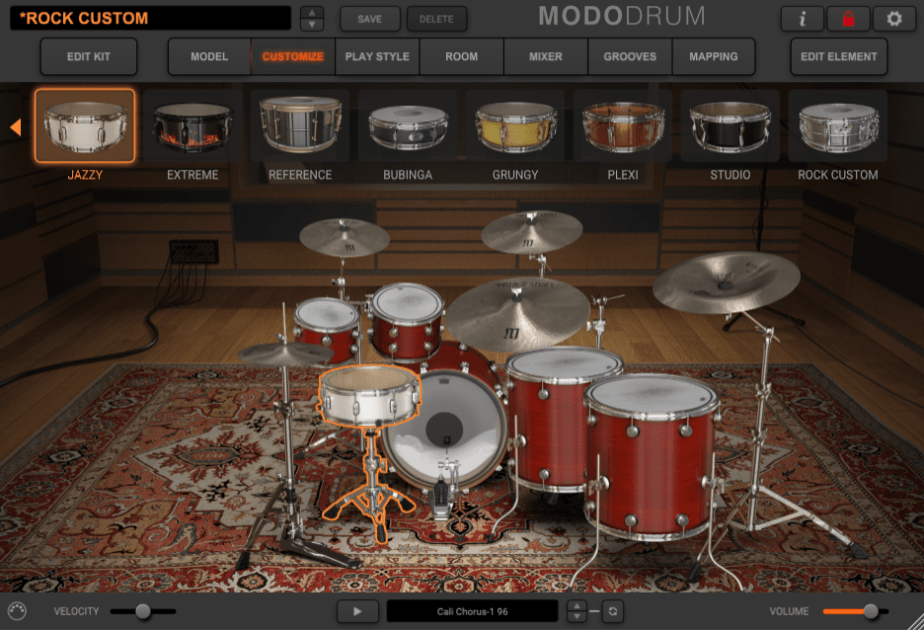
The Model and Customize tabs allow selection of a base kit, then swapping out individual drums to find the perfect sound. The base kit models are Studio, Jazzy, Rock Custom, Grungy, Djentleman, Black Oyster, Bubinga, Plexi, Extreme, and Reference. Select a kit on the Model tab, then head over to the Customize tab for both easy swap-outs and fine-tuning. Clicking the Edit Element button brings up granular model controls including top and bottom head types, shell type, snare size, and detailed mic input editing for room, overhead, and bleed. The Edit function also provides top and bottom head volumes, tuning, dampening, drum diameter and depth, and a group-level control for modifying all of the toms at once.
Play Style
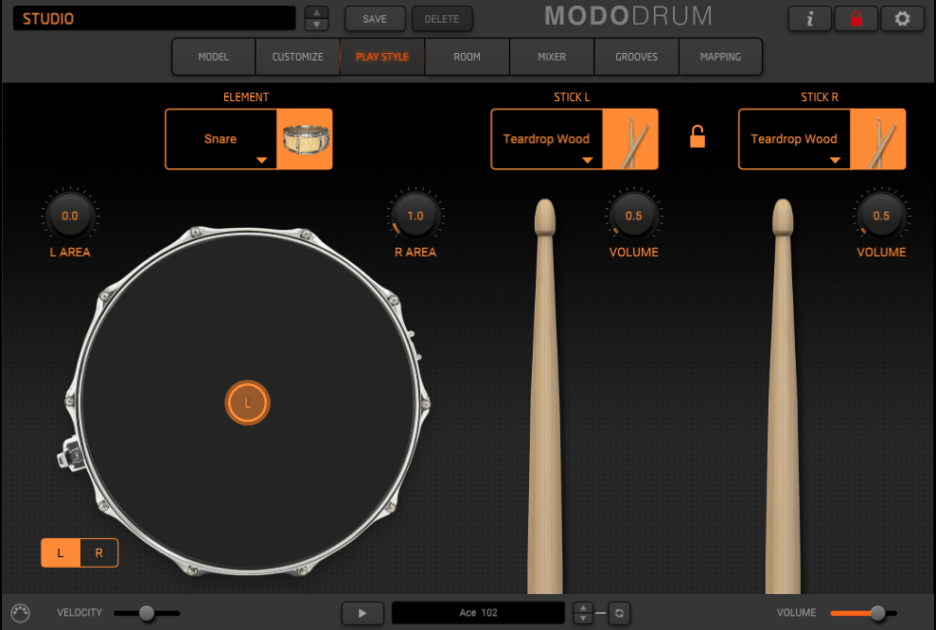
The Play Style tab offers granular control over where the sticks impact on the drum heads, with options for both left and right striking areas, stick types, and individual stick volumes. This is good for dialing in the right articulations and the amount of stick “clack” on the drum head surface. Stick types include wood with teardrop tip, nylon teardrop tip, and wood with no tip.
Room

Room offers nine different room sizes and reverb qualities, including Booth, Mid-size Studio, Garage, Bunker, Large Studio, Cathedral, Club, Venue, and Warehouse. The Booth, Studio, and Club reverbs offer warmer room reverb, while the others offer varying degrees of ringing echoes. There is a fold-out volume slider on the right side of the screen for fine-tuning the room input into the mixer.
Mixer
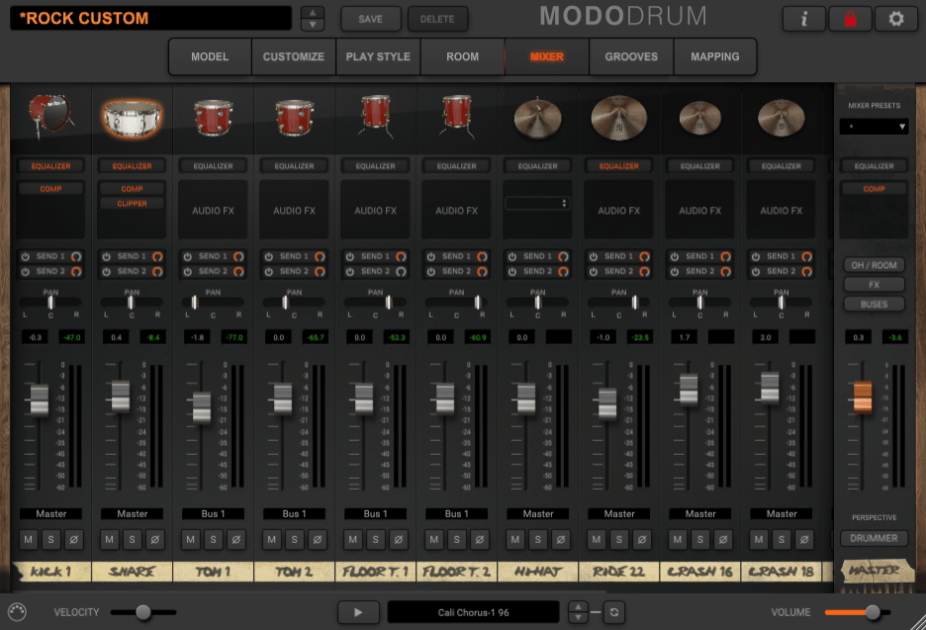
The Mixer tab in MODO DRUM is incredibly robust. Each individual fader channel has a parametric equalizer with up to 8 bands and Q control, four track-level effects, two effects sends with volumes, pan, fader, mute, solo, and phase. The track-level effects include a second parametric EQ, four compressor models and a gate, four distortions, four reverbs, two delays, and a phaser, chorus, and flanger. Clicking the FX button on the master folds out the two effects busses, each with equalizer and four buss-level effects, exactly the same as at track-level. Clicking the OH/Room button folds out two busses for overhead and room mics, also with EQ and effects. With the overhead and room busses engaged, the two effects sends on the other faders change to overhead and room sends for fine-tuning.
Grooves
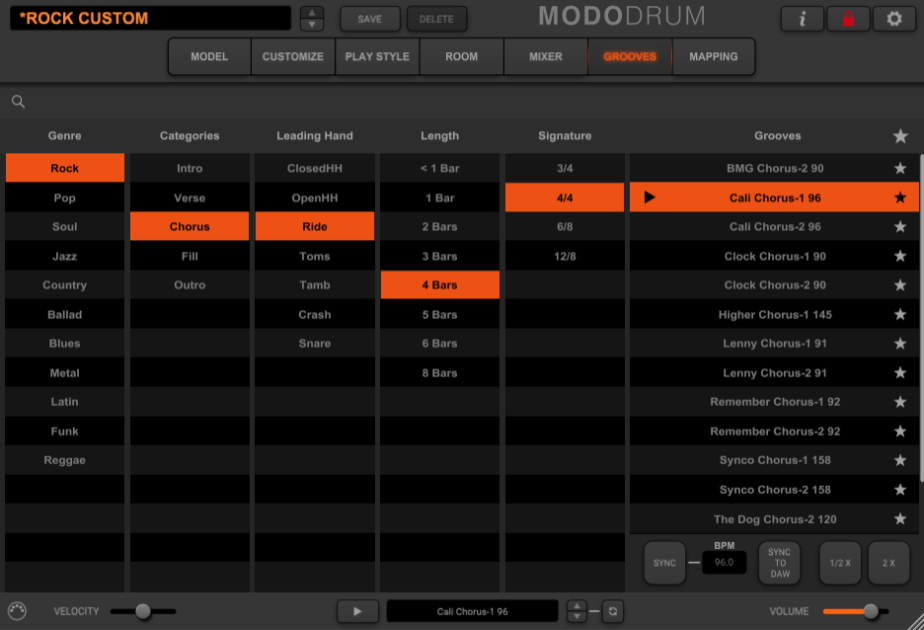
MODO DRUM ships with over 1,400 MIDI loops and fills which are accessible via the Grooves tab. The tab has four groups of keywords: Genre, Categories, Leading Hand, Length, and Signature. Each of the keywords is independently selectable to narrow down the available MIDI. For example, you can hit both Soul and Blues to see what is available in either genre at the same time. Clicking any of the Grooves loads it into the playhead. The Tempo controls allow for syncing grooves to the currently selected Groove’s BPM, or locking sync with the host DAW, as well as half-time and double-time. The playhead can be set to loop for easy tweaking of drum settings. Once the right Grooves are found, they can be dragged into the host DAW to add to your tracks.
Mapping

Rounding out the features of MODO DRUM is the Mapping tab, where each kitpiece and subsequent articulation can be individually mapped to any of the MIDI control messages. A piano roll at the bottom shows where each sound is mapped as you select them. Also included is a MIDI monitor to show control messages as they come in, as well as a Velocity Curve for setting increases or decreases to MIDI input velocity.

Usability
We’ll start with the good stuff. First off, the signal path options in MODO DRUM are pretty great. The mixer has multiple sends and an 8-band variable parametric EQ on every channel and send buss, and the built-in effects are varied and quite useful. The MIDI mapping features are excellent, and I found the MIDI monitor a welcome addition for custom-mapping my drum pads — normally I have to have MIDI-Ox open to accomplish that task. Finally, the Play Style options are very, very nice. Little details like what kind of kick beater (wood, felt, or plastic) make a huge difference in the sound and can’t be overlooked. This is the benefit of a modeler, as that level of detail in a sampled plugin would fill multiple hard drives.
Now for the not-so-good. In terms of usable presets, I felt like I had to really hunt for decent tones in MODO DRUM. With ten kits and over 80 presets I would have imagined that a few presets would be iffy with tons of bangers, but my experience was the opposite. There were lots of kits that I would consider 50-75% of the way towards usable out of the box, but nearly every kit required more tweaking than I’d really like to do at the start of a session. To me, a kit preset should be a solid set of tones that need a little tweaking to sit in the mix after the fact, not a hunt-and-peck for something that doesn’t sound awful. Nearly every preset seemed to have something that felt a bit off, like a snare that sounded present and toms that sounded washed, or cymbals that sounded tinny with a kick that sounds boomy and ringy.
Also, I ran into what I consider the strangest bug I’ve ever seen in a plugin. In the process of creating the sample for this review, I used the exact same MIDI that I used for all the others in the series. For some reason the plugin replaced two snare hits in the middle of the third phrase with a strange, soft “pong” noise. At first, I thought I somehow deleted the snare hits, even though I didn’t have the Reaper MIDI edit window open. I recovered an old version of the project just to be sure, then discovered the bug while tweaking the actual MIDI. If I set the velocity to 101, it makes the weird “pong,” but 100 and 102 both ring out like a normal snare. For the purposes of creating a fair sample for sound comparison I went ahead and tweaked both of the errant snare hits to 100, but between that and all the messing around I had to do to get what I felt were usable kits, I couldn’t possibly give this plugin a full five stars for usability.

Hear it in Action
Here’s a sample of MODO DRUM using the Studio Natural preset with a few tweaks on the Play Style, the effects sends, and the ride replaced with the IK ride instead of the vintage. (Also, as noted in the Usability section, I did make a slight tweak to the snare MIDI to make it play correctly.)
IK Multimedia MODO Drum Review – The Bottom Line
When I consider the value of a plugin, I look at how much it costs compared to the competition and how much use I could see myself getting at that price point. MODO DRUM comes in two flavors: MODO DRUM SE, which includes the Jazzy and Studio kits, and the full MODO DRUM with all ten kits included. I liked both the Jazzy and Studio kits, so at $149 retail I would find MODO DRUM SE to be usable, but nowhere near the value of some other plugins at that price, as that would only give you two snares to choose from. For $299 retail, I would be hard-pressed to call the full MODO DRUM a true value, as that puts it towards the top of the range in my roundup and I simply didn’t enjoy many of the other eight kits or their presets. That said, I can’t give MODO DRUM above three stars for value at this price.

There are a lot of things I enjoyed about MODO DRUM, but the drawbacks tended to outweigh the positives in my view. There are definitely usable drum tones to be found, and if it’s on a good enough sale I’d say you should demo it and give it strong consideration. Overall, MODO DRUM is a fairly new plugin, and as such I feel it has some growing to do to stack up to the competition in terms of value and usability. In conclusion, I give MODO DRUM four out of five stars with its current price and featureset. If they fixed the bug I found, reworked the presets, and/or lowered the price, I would gladly re-evaluate my rating.

Ten modeled drum kits with tons of control and effects.


